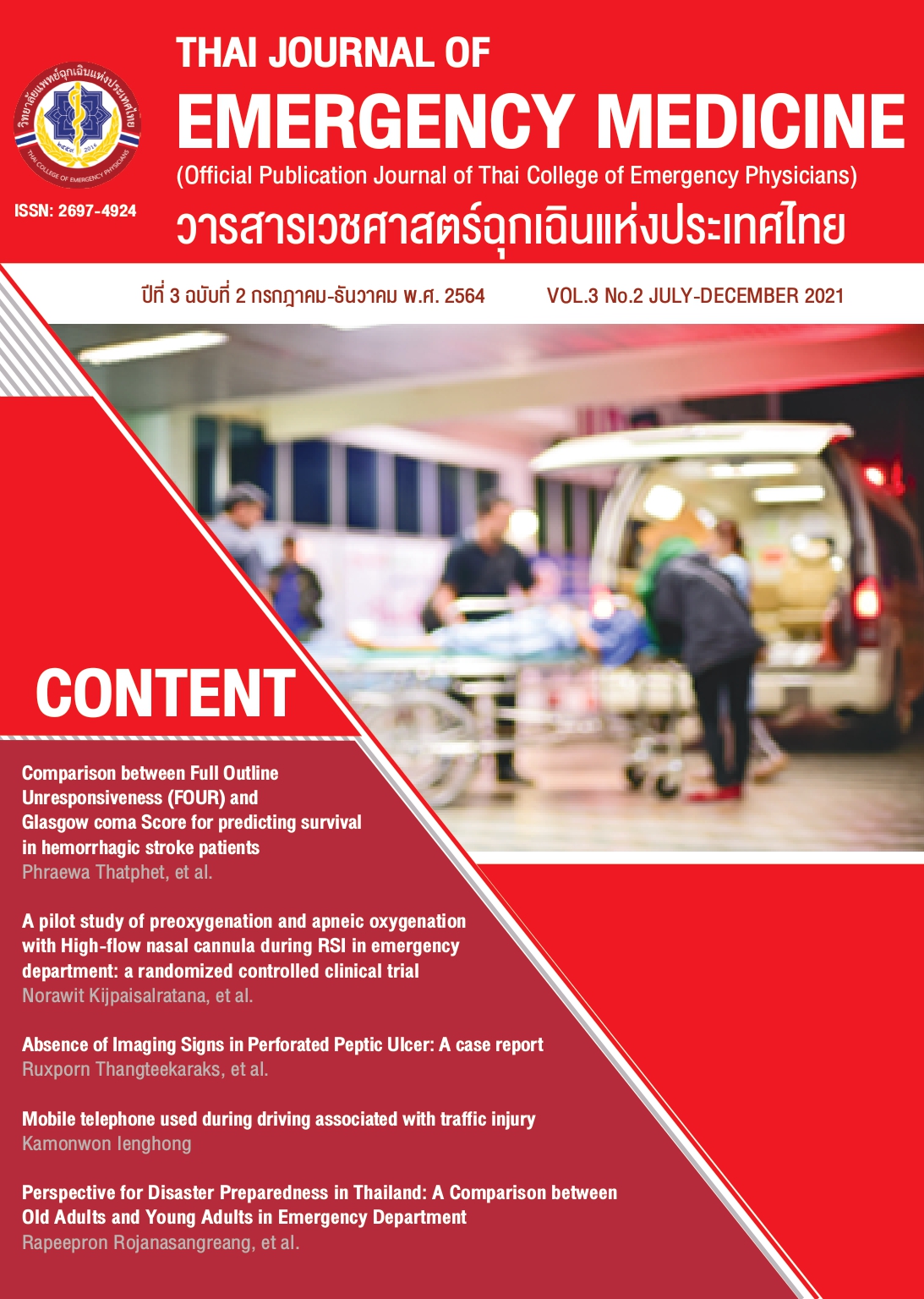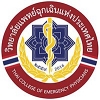Comparison between Full Outline Unresponsiveness (FOUR) and Glasgow coma Score for predicting survival in hemorrhagic stroke patients
Keywords:
FOUR score, Glasgow coma score, hemorrhagic strokeAbstract
Introduction: Hemorrhagic stroke is common disease That was found in the emergency department. The prognosis is poor and Glasgow coma score (GCS) has limited accuracy for predicting prognosis. Full Outline UnResponsiveness (FOUR) score is better than GCS for predicting prognosis and neurological outcome in ischemic stroke and post cardiac arrest patients. So we had concept for using FOUR score for predicting prognosis in these patients.
Objectives: to study prognostic accuracy of 28-day survival in hemorrhagic stroke patients who were predicted by FOUR and GCS.
Method: The prospective cohort study. We analyzed the data by STATA version 15.0 from 145 hemorrhagic stroke patients who visited The Emergency department at Chonburi hospital between 1st October- 31st December. For compare survival accuracy of FOUR score and GCS, we calculated the sensitivity, specificity, PPV, NPV and AUROC curves. Cox’s regression was analyzed mortality at appropriated cut off point.
Results: 145 patients were included in the study. Mean FOUR and GCS score were 8.6 ± 5.9 and 8.6± 4.4 respectively. Overall survival rate was 46.9% AUROC of FOUR score was 0.934 and GCS was 0.885 respectively. The hemorrhagic stroke patient who had FOUR score greater than or equal to 13 point, had greater tendency for 28 day than the other group. (Hazard ratio 39.21)
Conclusion: FOUR score have better prognostic accuracy than Glasgow coma score and for predicting survival in hemorrhagic stroke patients.
References
Teasdale G, Jennett B. Assessment of coma and impaired consciousness. A practical scale. Lancet Lond Engl. 1974;2(7872):81–4.
Sandroni C, Barelli A, Piazza O, Proietti R, Mastira D, Boninsegna R. What is the best test to predict outcome after cardiac arrest?. Eur J Emerg Med.1995;2(1):33-37
Udekwu P, Kromhout-Schiro S, Vaslef S, Baker C, Oller D. Glasgow Coma Scale score, mortality, and functional outcome in head-injured patients. J Trauma.2004;56(5):1084-9
Matis GK, Birbilis TA. Poor relation between Glasgow coma scale and survival after head injury. Med Sci Monit.2009;15(2):CR62-65
Fugate JE, Rabinstein AA, Claassen DO, White RD, Wijdicks EFM. The FOUR score predicts outcome in patients after cardiac arrest. Neurocrit Care. 2010 ;13(2):205–10.
Almojuela A, Hasen M, Zeiler FA. The Full Outline of UnResponsiveness (FOUR) Score and Its Use in Outcome Prediction: A Scoping Systematic Review of the Adult Literature. Neurocrit Care. 2019;31(1):162–75.
Foo CC, Loan JJM, Brennan PM. The Relationship of the FOUR Score to Patient Outcome: A Systematic Review. J Neurotrauma. 2019. 01;36(17):2469–83.
Bayraktar YS, Sahinoglu M, Cicekci F, Kara I, Karabagli H, Duman A, et al. Comparison of Glasgow Coma Scale and Full Outline of Unresponsiveness (Four) Score: A Prospective Study. Turk Neurosurg. 2019;29(2):285–8.
Temiz NC, Kose G, Tehli O, Acikel C, Hatipoglu S. A Comparison Between the Effectiveness of Full Outline of Unresponsiveness and Glasgow Coma Score at Neurosurgical Intensive Care Unit Patients. Turk Neurosurg. 2018;28(2):248–50.
Sepahvand E, Jalali R, Mirzaei M, Ebrahimzadeh F, Ahmadi M, Amraii E. Glasgow Coma Scale Versus Full Outline of UnResponsiveness Scale for Prediction of Outcomes in Patients with Traumatic Brain Injury in the Intensive Care Unit. Turk Neurosurg. 2016;26(5):720–4.
Zeiler FA, Lo BWY, Akoth E, Silvaggio J, Kaufmann AM, Teitelbaum J, et al. Predicting Outcome in Subarachnoid Hemorrhage (SAH) Utilizing the Full Outline of UnResponsiveness (FOUR) Score. Neurocrit Care. 2017;27(3):381–91.
Ramazani J, Hosseini M. Comparison of full outline of unresponsiveness score and Glasgow Coma Scale in Medical Intensive Care Unit. Ann Card Anaesth. 2019;22(2):143–8.
Iyer VN, Mandrekar JN, Danielson RD, Zubkov AY, Elmer JL, Wijdicks EFM. Validity of the FOUR score coma scale in the medical intensive care unit. Mayo Clin Proc. 2009;84(8):694–701.
Wijdicks EFM, Bamlet WR, Maramattom BV, Manno EM, McClelland RL. Validation of a newcoma scale: The FOUR score. Ann Neurol. 2005;58(4):585–93.
Buderer NMF. Statistical methodology: I. Incorporating the prevalence of disease into the sample size calculation for sensitivity and specificity. Acadademic Emergency Medicine.1996; 3(9):895-900.
Surabenjawong U, Sonmeethong W, Nakornchai T. Accuracy of Glasgow Coma Score and FOUR Score: A Prospective Study in Stroke Patients at Siriraj Hospital.J Med Thai 2017;100(9):960-6
Mansour OY. Megahed MM. Elghany EHSA. Acute ischemic stroke prognostication, comparison between Glasgow Coma Score, NIHS Scale and Full Outline of UnResponsiveness Score in intensive care unit, Alex J Med.2014;51(3):247-53
Kocak Y, Ozturk S, EGE F, EKMEKCI AH. A useful new coma scale in acute stroke patients: FOUR score. Anaesth Intensive Care.2012;40:131-6
Braksick SA, Hemphill III JC, Mandrekar J, Wijdicks EFM, Fugate JE. Application of FOUR score in intracerebral hemorrhage risk analysis.J Stroke Cerebrovasc Dis. 2018;27(6):1565-9

Downloads
Published
How to Cite
Issue
Section
Categories
License
Copyright (c) 2022 Thai Collage of Emergency Physicians

This work is licensed under a Creative Commons Attribution-NonCommercial-NoDerivatives 4.0 International License.
บทความที่ได้รับตีพิมพ์ในวารสารเวชศาสตร์ฉุกเฉินแห่งประเทศไทย ถือเป็นเป็นลิขสิทธิ์ของ วิทยาลัยแพทย์เวชศาสตร์ฉุกเฉินแห่งประเทศไทย
กรณีที่บทความได้รับการตีพิมพ์ในวารสารเวชศาสตร์ฉุกเฉินแห่งประเทศไทยแล้ว จะตีพิมพ์ในรูปแบบอิเล็กทรอนิกส์ ไม่มีสำเนาการพิมพ์ภายหลังหนังสือเผยแพร่เรียบร้อยแล้ว ผู้นิพนธ์ไม่สามารถนำบทความดังกล่าวไปนำเสนอหรือตีพิมพ์ในรูปแบบใดๆ ที่อื่นได้ หากมิได้รับคำอนุญาตจากวารสารเวชศาสตร์ฉุกเฉินแห่งประเทศไทย



